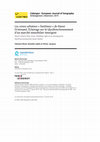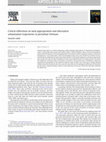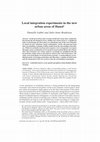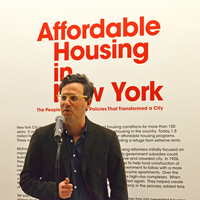Books by Danielle Labbé
Hoa Muc was a small locality on the edge of Hanoi that made the shift from rural village to urban... more Hoa Muc was a small locality on the edge of Hanoi that made the shift from rural village to urban neighbourhood over the course of the last century. This book tells the story of urbanization at the rural-urban interface of Hanoi during this period. It explores the socio-political mechanisms that underpinned the formation and evolution of villagers’ livelihoods and land strategies in relation to the ebb and flow of state regulations and territorialization projects. Through the story of this erstwhile village, this volume reconsiders the relationship between urban changes, the state’s governing practices, and grassroots decisions and actions.
Journal articles by Danielle Labbé

Cybergéo, 2019
Au début des années 1990, dans le prolongement des réformes ayant placé le Vietnam sur la voie de... more Au début des années 1990, dans le prolongement des réformes ayant placé le Vietnam sur la voie de l’« économie de marché à orientation socialiste », un marché immobilier est réapparu dans les grandes villes du pays. À Hanoi, ville sur laquelle porte cet article, le marché immobilier est, depuis sa réémergence, particulièrement volatile et marqué par une succession de cycles d’emballement-récession. C’est dans ce contexte qu’ont émergé, à la fin des années 2000, des zones urbaines dites « fantômes ».
À partir d’une approche empruntée à l'économie politique, l’analyse de l’apparition de ces zones « fantômes » met en lumière le « virage immobilier » pris par l’État-parti vietnamien. Ce virage s’est notamment traduit par l’adoption et la promotion, par les autorités étatiques, d’un nouveau modèle de production de l’espace urbain appelé « Nouvelles zones urbaines », par la monétisation de la ressource foncière et son accaparement par nombreux acteurs économiques (étatiques ou non) étroitement liés aux sphères politico-administratives. Ce travail révèle comment ces singularités de l’environnement politico-économique vietnamien ont façonné les pratiques en matière de développement urbain au cours des années 2000.

This paper examines the recent emergence, on the periphery of Hanoi, of large real estate project... more This paper examines the recent emergence, on the periphery of Hanoi, of large real estate projects that began construction during the 2000s but have now remained unfinished or, even when completed, largely uninhabited. These "ghost urban areas," as the local press calls them, epitomize some of the problems which emerged in Hanoi when a model of urban development that aimed at realizing an imagined urban future, formulated by state planning agencies, encountered the highly speculative reality of Vietnam's property market. Ghost urban areas reveal how the state's planning orientations and discourse-conveying ideals of urban "modernity," "civility," and particularly "synchrony"-instead generated dysfunctional, incomplete, and disconnected places. Based on a survey of thirty-nine ghost urban areas, a cartographic analysis, interviews with key actors, and a critical study of policy documents, this paper reveals multiple scales and forms of what we call "asynchronous territorial developments." Around Hanoi, these developments involve vast tracts of agricultural lands forcibly appropriated yet left fallow, planned infrastructure and amenities that stay unbuilt for indefinite periods of time, and housing units transacted multiple times among speculators but have remained largely uninhabited and out of reach for a majority of urban households. Ultimately, we interrogate how these various territorial asynchronies, both generated by and plaguing ghost urban areas, shape their livability and inhabitants' experience.
Faced with increasingly rapid urban sprawl, developing Asian cities struggle to control their urb... more Faced with increasingly rapid urban sprawl, developing Asian cities struggle to control their urbanization. While Hanoi, the capital of Vietnam, is also struggling to curb its own rapid urbanization, in the 1990s, the government adopted a new policy to orient and shape urban expansion. This policy is based on the planning and construction of " new urban areas " (khu do thi moi). This article provides a cartographic analysis of the implementation of these areas across the city-province's territory and examines issues related to their territorial expansion.

Vietnam recently started to recognise the multiple benefits brought by open and green spaces to ... more Vietnam recently started to recognise the multiple benefits brought by open and green spaces to urban population and environment. In this paper, we analyse the provision of open and green spaces (parks, public gardens and lakeshores) in Hanoi. Using a model proposed by Talen (2010), we examine the spatial evolution of these spaces between 2000 and 2010, their level of proximity to residential units, and the extent to which their distribution matches social needs (defined in terms of population density). We find that while the absolute number and surface area of parks and public gardens has increased significantly in Hanoi, these new public spaces are mainly built on the city’s newly urbanised periphery. As a result, in 2010, only 15% of Hanoi’s residential blocks had access to a park or public garden within a reasonable walking (1000m) or biking distance (2500m). Moreover, the city’s densest residential areas have only access to relatively small gardens and parks, resulting in overcrowding. Lakeshores, however, represent an opportunity to enhance access to open and green spaces in Hanoi due to their spatial distribution. We conclude by advocating for the integration of spatial measures of proximity and needs into Hanoi’s public space planning policy framework.

In the early 2000s, Vietnam and Mexico turned to the private sector to respond to increasing hous... more In the early 2000s, Vietnam and Mexico turned to the private sector to respond to increasing housing demand and tame the growth of uncontrolled periurban settlements. Around Hanoi, such arrangements fostered the construction of vertical developments while large subdivisions of single-family houses spread over former lakebeds in the peripheries of Mexico City. A stronger role of the private sector in the planning and provision of housing is often seen as an outcome of crisis-driven and crisis-inducing neoliberal reforms. However, the cases of Vietnam and Mexico suggest that a fuller understanding of housing production strategies currently favoured by each state needs to account for important elements of continuity in social, political, and economic practices. This continuity is demonstrated through the comparative analysis of three aspects of the restructuring of housing production in Mexico City’s and Hanoi’s periurban areas: (i) the discourses of ‘order’ used to legitimate heightened private sector involvement, (ii) legislative reforms facilitating periurban land appropriation for redevelopment, and (iii) the socio-spatial outcomes of these recent changes in terms of housing affordability, liveability, and quality. We conclude that both city-regions, despite important differences in their institutional and economic systems display enduring state/market/civil society relations associated with processes of ‘uneven state formalization’. This continuity and unevenness, we argue, better explains recent transformations of periurban housing production than an emphasis on the ruptures resulting from neoliberal reforms.

Starting in the 2000s, there has been a rise in youth-led appropriation of public spaces in Hanoi... more Starting in the 2000s, there has been a rise in youth-led appropriation of public spaces in Hanoi, Vietnam. Through case studies of skateboarders and traceurs (practitioners of parkour) in two of the city’s formal public spaces, we explore and analyze the tactics deployed by these young urbanites to claim a part of the characteristically overcrowded and socio-politically restrictive public spaces of the Vietnamese capital. These case studies show that, by seeking to access public spaces for their new activities, skaters and traceurs have had to confront multiple sets of rules, imposed by not only the state, but also corporate actors and resident-driven surveillance. We find that skateboarders and traceurs deal with these forms of control largely through small-scale, non-ideological, and non-confrontational tactics. As a result, these youth practices have become normalized in Hanoi’s public spaces. These findings broaden the discourses on everyday urbanism and social- political transformations in post-socialist urban contexts, and shed light on the ways in which contemporary youths engage with the city.

Vietnam's land regime is currently undergoing a radical reshaping under policies of “urbanization... more Vietnam's land regime is currently undergoing a radical reshaping under policies of “urbanization and modernization.” Around large urban centres what could be called a “Third Land Reform” fosters massive land-takings for urban-industrial expansion. The forced appropriation of farmlands unsettles endogenous patterns of mixed-use development or “rural-urbanization” which have developed in these zones since the đổi mới, and which are characterized by the combination of small-scale cottage industries with mixed employment, and commuting into the cities for jobs and trade. The Third Land Reform is driven by an official discourse of “modernization” that deems the endogenous rural-urbanization as backward (not modern). This discourse drives and defends an aggressive programme of expropriation, to the benefit of corporate capital, to build “real” urban spaces. Foreign, planning scholars should not merely describe these processes, but point out the ideological justifications driving them, and the ways in which the things it rejects as non-viable may, in fact, have virtues that have been missed by the official view.

This article explores the role of media-led dissent in Vietnam's contemporary land struggles. The... more This article explores the role of media-led dissent in Vietnam's contemporary land struggles. The analysis focuses on Vietnamese-language material published online by domestic and foreign media about the so-called Văn Giang incident – a high-profile land dispute that shook the country between 2009 and 2012. Looking at how the media treated this incident broadens studies of land struggles in Vietnam, which up till now have focused on peasants’ resistance strategies. This case not only shows that media practitioners engage in dissent with regard to land politics, but also that they engage in more straightforward criticism of the state and its corporate redevelopment partners than what most analyses of rural land struggles in Vietnam, centered on the micro-level and on “lawful” (O'Brien) forms of resistance, would lead one to believe. Illustrating this point, the author shows that media dissent throughout the Văn Giang land dispute openly challenged the government's justificatory discourse about “displacement for development” as well as the mismanagement of land resources on which political and economic elites rely to dispossess peasants from peri-urban lands. If it has not yet provoked major institutional changes, the media's contribution to land struggles has nevertheless succeeded in creating a genuine, national public debate on land politics in rapidly urbanizing Vietnam.

In the peri-urban zones of many South East Asian cities, capital has flowed into the development ... more In the peri-urban zones of many South East Asian cities, capital has flowed into the development of new, middle class urban enclaves. A significant body of scholarship sees these places as embodying some of the worst elements of American-style suburban, gated communities: sterile, disconnected from their surroundings, isolating wealthy people from the surrounding urban life, etc. While it is no doubt true that such a negative view is frequently warranted, through a closer examination of two projects in peri-urban Hanoi, the authors show that Vietnam's new urban enclaves can hardly be assimilated into the hermetically sealed enclaves described in much of the critical literature. The study cases from Hanoi reveal much more porosity: a strong influence of traditional modes of housing production and allocation, a mixing of built forms and the integration of the new enclaves into the surrounding communities.

Urban Studies, Jul 11, 2013
Starting in the 1990s, the Vietnamese state sought to expand and modernise the country’s urban sy... more Starting in the 1990s, the Vietnamese state sought to expand and modernise the country’s urban system after four decades of anti-urban policies. This paper examines the reworking of the socialist land regime that followed from this shift. It begins by explaining how new legislation and institutions combined market and socialist principles to lure domestic enterprises into realising the state’s new urban ambitions. It then shows how this hybrid reordering of policy triggered local experiments with periurban land redevelopment and new forms of alliances between the state and private capital. Using the case of the Land-for-Infrastructure mechanism, which uses land as in-kind payment for the building of infrastructure, it is found that this experiment undermines the implementing of official planning orientations and regulations. Finally, the paper explores the relationship between this problematic outcome and the political-economic environment within which recent land policy changes have been implemented in Vietnam.

This paper discusses the recent rise in land disputes in the rapidly urbanizing outskirts of Hano... more This paper discusses the recent rise in land disputes in the rapidly urbanizing outskirts of Hanoi. It presents emerging social conflicts as resulting from a clash between the rules and practices of urbanization as devised and regulated locally by periurban people and the territorialisation project that municipal authority and land developers try to impose on them. At the heart of these conflicts is the compulsory acquisition of large tracts of periurban land by state-backed developers and reforms of local institutions that facilitate this process. Using the case of a village recently annexed to the city, this paper examines how local people resort to contentious politics to resist this urban encroachment. The paper finds that groups of elderly assumed a leading role in crafting and deploying acts and discourses of resistance, relying on state-promoted values to support their claim. It further suggests that, while periurban villagers acknowledge the necessity of integrating their locality into Hanoi's urban fabric and governance system, they rise up when this process threatens moral relationships inherited from the prerevolutionary and collectivization periods.

Since the late 1990s, a new model of urban development has been promoted in Vietnam. So-called 'n... more Since the late 1990s, a new model of urban development has been promoted in Vietnam. So-called 'new urban areas' are being built on the agricultural lands at the periurban interface of cities across the country. These large-scale redevelopments feature commodity housing and public services, along with commercial and office space. Foreign scholars have criticised the lack of integration between these built environments and existing urban agglomerations. The resulting urban fragmentation is commonly blamed on the imposition of a foreign model of urban development that promotes a break with previous urban space production mechanisms. This paper provides a nuanced view on these ideas by exploring the history of housing policy in Vietnam and in the region of Hanoi in particular. This approach underscores the locally situated nature of the new urban area experiments. At the same time, it reveals the need to explore ongoing shifts in the way various groups straddling the state, markets and society interact in contemporary urban space production processes.
La capitale du Vietnam a connu en 2008 une redéfinition de son périmètre administratif en intégra... more La capitale du Vietnam a connu en 2008 une redéfinition de son périmètre administratif en intégrant une province voisine, Ha Tay. Résultat d’un geste politique fort, la recomposition territoriale de cette capitale d’Asie du Sud-Est au dynamisme économique envié cache un enchevêtrement d’enjeux politiques et économiques associé au foncier. En effet, depuis l’ouverture économique du Vietnam au milieu des années 1980, le foncier a joué un rôle essentiel dans l’enrichissement de plusieurs franges de la société. Les politiques territoriales d’attraction des investissements privés et les stratégies élaborées par les acteurs du développement urbain pour l’accès au foncier ont été à l’origine de la reprise en main d’une province limitrophe de la capitale par le pouvoir central. La pression qui s’exerçait sur la terre compromettait le développement harmonieux de la capitale du Vietnam.

Large residential complexes mushroom on city outskirts, as Viêt Nam enters an accelerated rate of... more Large residential complexes mushroom on city outskirts, as Viêt Nam enters an accelerated rate of urbanization. The “new urban zones” are causing sociospatial and socioeconomic
fragmentation, while some foreign researchers compare these new suburban zones to “gated communities”, and criticize the perverse effects of privatization, commodification, and securitization – central concepts in the literature on neoliberalization. This theoretical framework seems inappropriate for Viêt Nam, even if criticism of the negative aspects of this urbanization model continues to be a necessity. Rooted in studies on two new urban zones on the periphery of Hanoi City, this article analyzes sociospatial and socioeconomic fragmentation at three phases of their life cycle; namely, conceptualization and funding, construction and realization, as well as everyday living practices. This approach casts light on the many “reweaving” and negotiating practices linking the new zones and neighbouring districts; and finally, it identifies the real causes of urban fragmentation: the principles of modernist planning and property speculation.
Book chapters by Danielle Labbé
Comprendre l'habitat …, Jan 1, 2006
Before economic reforms were introduced in the mid-80s, following the Dot Môi policy, Viêt Nam&am... more Before economic reforms were introduced in the mid-80s, following the Dot Môi policy, Viêt Nam's residential fabric had remained much the same since the end of the French colonial era in the 50s. After the Dôi Môi policy was introduced, it started to change. It was the case ...

Harbin to Hanoi: The Colonial Built Environment in Asia, 1840 to 1940, 2013
This chapter discusses the production of residential space in the city of Hanoi, Vietnam in the d... more This chapter discusses the production of residential space in the city of Hanoi, Vietnam in the decades preceding the first Indochinese War (roughly from 1900 to 1945). It focuses on the morphogenesis of the Bui Thi Xuan Quarter – a small area south of the colonial city where a hybrid housing type emerged from the encounter between French colonial and Vietnamese residential cultures. The urban fabric of this neighbourhood is dominated by a housing type called the villa-compartiment . This building type was created by Vietnamese architects trained under the French for an emerging Vietnamese middle-class. It is a unique built form in Hanoi in that it reconciles pre-colonial traditions of producing and inhabiting private space with emerging tastes for modernity and cosmopolitanism.
The building of the Bui Thi Xuan area is, in and of itself, a fascinating moment in the architectural history of Hanoi revealing how local and exogenous housing cultures, professional training institutions, and local actors coalesced during a short but highly vibrant period of cultural exchanges. But this small neighbourhood and its unique villa-compartiments also deserve attention because of their influential role in the renaissance of private housing production at the end of the subsidy era (post-1986). This chapter argues that there is a direct relationship between the Bui Thi Xuan experiment and the physical expression of Hanoi’s recent housing boom.
The chapter begins with a critical appraisal of the housing typologies found in studies of urban Vietnam under the French (e.g. Leaf 2000; Clément 2001; Logan 2000). This literature generally describes Hanoi as consisting of three generative housing types. These are, in turn, associated with three spatial zones in the city. From the center to the rural outskirts come in turn: the tube-house characteristic of the so-called Old Quarter, a craft and trade area that developed next to the Imperial City dating to the 10th century; south and west of this area is the villa-pavilion, an exogenous built form introduced by the French in the residential neighbourhoods developed to shelter French colonials and their administration; and finally, surrounding the colonial and indigenous city is the rural house found in periurban villages.
After a brief description of each building type, we present a fourth and distinct housing type which is first observed in the Bui Thi Xuan area at the beginning of the 20th century. The so-called villa-compartiment is generally classified as a variation of the colonial villa-pavilion and is only mentioned in passing in studies of Hanoi’s built form. In this paper, we argue that the villa-compartiment results from a process of mixing between local and Western built forms that goes beyond the technological and stylistic exchanges observed between the tube-house, villa-pavilion, and rural house. The lack of scholarly interest in the villa-compartiment might be explained by the fact that these buildings exist in smaller numbers in Hanoi than the three other housing types discussed above. Moreover, they do not have the haughtiness of the villa-pavilion or the vernacular appeal of the tube-house and rural house. We suggest that the villa-compartiment is also neglected by students of housing production in Hanoi –the majority of whom are concerned with built heritage issues– because of its syncretism which, from a narrow preservationist point of view, lessens its interest.
In this paper, we take the opposite stance, arguing that it is this very genre mixing that makes the villa-compartiment an object worth studying. In the second part of the paper,we explain how the Bui Thi Xuan area became the “live” laboratory of the first cohort of Vietnamese architects trained by l’École des Beaux-Arts de l’Indochine (EBAI) and l’École Française d’Extrême-Orient (EFEO), two institutions where, since the late 19th century, lively discussions were taking place on how to bridge Vietnamese traditions and Western modernity and tastes in the design of new living environments. This section recounts how a handful of young indigenous professionals, freshly graduated from colonial training institutions, were commissioned to design new houses for a group of middle-class Vietnamese civil servants working for the French. We discuss, how, through this collaboration, the young architects carefully chose and assembled elements of the spatial organization and stylistic expressions of the tube-house and villa-pavilion to create a new building type and how, in so doing, they reinvented the forms, uses, and expressions of housing space in Hanoi.
The chapter concludes with a discussion of the influence that the villa-compartiment had on the development of Hanoi’s urbanization after the launch of doi moi, a package of socioeconomic reforms that relaxed state control on private housing production. When Vietnamese households and professionals were once again given the opportunity to produce housing on an individual basis -- after 30-years of state-led, collective housing experiments-- they privileged the construction of variations on the model of villa-compartiment. By the late 90s, the villa-compartiment had become the dominant housing type not only in the capital city’s urbanizing areas but also in rural areas located outside of Hanoi. Half-a-century after the Bui Thi Xuan experiment, local households and professionals maintained the same cultural preconception: to actualize local traditions through Western modernity.
References
Clément, P., Ed. (2001). Hanoi, le cycle des métamorphose: Formes architecturales et urbaines. Paris, Recherches.
Leaf, M. (2000). Structure, Spontaneity, and the Changing Landscape of Hanoi. Southeast Asian Urban Environments:Structured and Spontaneous. Chifos, C. and R. Yabes Eds. Tempe, Arizona, Program for Southeast Asian Studies: 73-111.
Logan, W. S. (2000). Hanoi: Biography of a city. Syndey, UNSW Press.
Pedelahore, C. (2004) Hanoi, entre urbanisme duel et urbanisme dialogique: formes d'opposition et formes de conciliation des acteurs de l'urbain. Hanoi, GEMCLEV and ISTED"
SUBURBAN CONSTELLATIONS: Governance, Land and Infrastructure in the 21st Century , Jul 2013

This chapter explores the impacts that two of the earliest new towns built on the margins of Hano... more This chapter explores the impacts that two of the earliest new towns built on the margins of Hanoi, the Vietnamese capital city, have had on the everyday life and livelihood strategies of the preexisting populations of two former rural
settlements located next to them. Combining a longer-term perspective with the social disaggregation approach allows us to critically revisit frameworks of analysis founded on the notions of urban segregation, socioeconomic marginalisation and infrastructural splintering that predominate in the literature
about the impacts of large land redevelopment on preexisting populations in the ASEAN. While we do not dispute the fact that the land dispossession that makes large land redevelopments possible disrupts the socioeconomic life of the preexisting population, we find that, after a few years, local populations hold a rather positive view of the new urban environment built on their land and that they can — and actually do — experiment with various livelihood strategies once projects are built and inhabited. Rather than drawing attention away from the difficulties faced by former peasants during the transition out of agrarian life, this study highlights the need to identify the conditions that underpin households’ livelihood adaptations in order to develop more appropriate policy measures and to apply them earlier on during the land redevelopment process.
Working Papers by Danielle Labbé
This working paper discusses the evolution of urbanization and regional development in Việt Nam’s... more This working paper discusses the evolution of urbanization and regional development in Việt Nam’s Red River Delta region focusing on the period from the late pre-colonial era up to the beginning of the socio-economic reforms of the Đổi mới.It identifies and characterizes the major societal, economic and urban and rural spatial transformations which occurred in the
delta during the 19th and 20 th centuries. These changes are examined in relation to territorial land features, historical events, successive political regimes and their associated urban and regional planning ideologies. The discussion considers endogenous processes that drive the development of urban centres and the countryside as well as interactions between these processes and state-led urban policies, plans and strategies.











Uploads
Books by Danielle Labbé
Journal articles by Danielle Labbé
À partir d’une approche empruntée à l'économie politique, l’analyse de l’apparition de ces zones « fantômes » met en lumière le « virage immobilier » pris par l’État-parti vietnamien. Ce virage s’est notamment traduit par l’adoption et la promotion, par les autorités étatiques, d’un nouveau modèle de production de l’espace urbain appelé « Nouvelles zones urbaines », par la monétisation de la ressource foncière et son accaparement par nombreux acteurs économiques (étatiques ou non) étroitement liés aux sphères politico-administratives. Ce travail révèle comment ces singularités de l’environnement politico-économique vietnamien ont façonné les pratiques en matière de développement urbain au cours des années 2000.
fragmentation, while some foreign researchers compare these new suburban zones to “gated communities”, and criticize the perverse effects of privatization, commodification, and securitization – central concepts in the literature on neoliberalization. This theoretical framework seems inappropriate for Viêt Nam, even if criticism of the negative aspects of this urbanization model continues to be a necessity. Rooted in studies on two new urban zones on the periphery of Hanoi City, this article analyzes sociospatial and socioeconomic fragmentation at three phases of their life cycle; namely, conceptualization and funding, construction and realization, as well as everyday living practices. This approach casts light on the many “reweaving” and negotiating practices linking the new zones and neighbouring districts; and finally, it identifies the real causes of urban fragmentation: the principles of modernist planning and property speculation.
Book chapters by Danielle Labbé
The building of the Bui Thi Xuan area is, in and of itself, a fascinating moment in the architectural history of Hanoi revealing how local and exogenous housing cultures, professional training institutions, and local actors coalesced during a short but highly vibrant period of cultural exchanges. But this small neighbourhood and its unique villa-compartiments also deserve attention because of their influential role in the renaissance of private housing production at the end of the subsidy era (post-1986). This chapter argues that there is a direct relationship between the Bui Thi Xuan experiment and the physical expression of Hanoi’s recent housing boom.
The chapter begins with a critical appraisal of the housing typologies found in studies of urban Vietnam under the French (e.g. Leaf 2000; Clément 2001; Logan 2000). This literature generally describes Hanoi as consisting of three generative housing types. These are, in turn, associated with three spatial zones in the city. From the center to the rural outskirts come in turn: the tube-house characteristic of the so-called Old Quarter, a craft and trade area that developed next to the Imperial City dating to the 10th century; south and west of this area is the villa-pavilion, an exogenous built form introduced by the French in the residential neighbourhoods developed to shelter French colonials and their administration; and finally, surrounding the colonial and indigenous city is the rural house found in periurban villages.
After a brief description of each building type, we present a fourth and distinct housing type which is first observed in the Bui Thi Xuan area at the beginning of the 20th century. The so-called villa-compartiment is generally classified as a variation of the colonial villa-pavilion and is only mentioned in passing in studies of Hanoi’s built form. In this paper, we argue that the villa-compartiment results from a process of mixing between local and Western built forms that goes beyond the technological and stylistic exchanges observed between the tube-house, villa-pavilion, and rural house. The lack of scholarly interest in the villa-compartiment might be explained by the fact that these buildings exist in smaller numbers in Hanoi than the three other housing types discussed above. Moreover, they do not have the haughtiness of the villa-pavilion or the vernacular appeal of the tube-house and rural house. We suggest that the villa-compartiment is also neglected by students of housing production in Hanoi –the majority of whom are concerned with built heritage issues– because of its syncretism which, from a narrow preservationist point of view, lessens its interest.
In this paper, we take the opposite stance, arguing that it is this very genre mixing that makes the villa-compartiment an object worth studying. In the second part of the paper,we explain how the Bui Thi Xuan area became the “live” laboratory of the first cohort of Vietnamese architects trained by l’École des Beaux-Arts de l’Indochine (EBAI) and l’École Française d’Extrême-Orient (EFEO), two institutions where, since the late 19th century, lively discussions were taking place on how to bridge Vietnamese traditions and Western modernity and tastes in the design of new living environments. This section recounts how a handful of young indigenous professionals, freshly graduated from colonial training institutions, were commissioned to design new houses for a group of middle-class Vietnamese civil servants working for the French. We discuss, how, through this collaboration, the young architects carefully chose and assembled elements of the spatial organization and stylistic expressions of the tube-house and villa-pavilion to create a new building type and how, in so doing, they reinvented the forms, uses, and expressions of housing space in Hanoi.
The chapter concludes with a discussion of the influence that the villa-compartiment had on the development of Hanoi’s urbanization after the launch of doi moi, a package of socioeconomic reforms that relaxed state control on private housing production. When Vietnamese households and professionals were once again given the opportunity to produce housing on an individual basis -- after 30-years of state-led, collective housing experiments-- they privileged the construction of variations on the model of villa-compartiment. By the late 90s, the villa-compartiment had become the dominant housing type not only in the capital city’s urbanizing areas but also in rural areas located outside of Hanoi. Half-a-century after the Bui Thi Xuan experiment, local households and professionals maintained the same cultural preconception: to actualize local traditions through Western modernity.
References
Clément, P., Ed. (2001). Hanoi, le cycle des métamorphose: Formes architecturales et urbaines. Paris, Recherches.
Leaf, M. (2000). Structure, Spontaneity, and the Changing Landscape of Hanoi. Southeast Asian Urban Environments:Structured and Spontaneous. Chifos, C. and R. Yabes Eds. Tempe, Arizona, Program for Southeast Asian Studies: 73-111.
Logan, W. S. (2000). Hanoi: Biography of a city. Syndey, UNSW Press.
Pedelahore, C. (2004) Hanoi, entre urbanisme duel et urbanisme dialogique: formes d'opposition et formes de conciliation des acteurs de l'urbain. Hanoi, GEMCLEV and ISTED"
settlements located next to them. Combining a longer-term perspective with the social disaggregation approach allows us to critically revisit frameworks of analysis founded on the notions of urban segregation, socioeconomic marginalisation and infrastructural splintering that predominate in the literature
about the impacts of large land redevelopment on preexisting populations in the ASEAN. While we do not dispute the fact that the land dispossession that makes large land redevelopments possible disrupts the socioeconomic life of the preexisting population, we find that, after a few years, local populations hold a rather positive view of the new urban environment built on their land and that they can — and actually do — experiment with various livelihood strategies once projects are built and inhabited. Rather than drawing attention away from the difficulties faced by former peasants during the transition out of agrarian life, this study highlights the need to identify the conditions that underpin households’ livelihood adaptations in order to develop more appropriate policy measures and to apply them earlier on during the land redevelopment process.
Working Papers by Danielle Labbé
delta during the 19th and 20 th centuries. These changes are examined in relation to territorial land features, historical events, successive political regimes and their associated urban and regional planning ideologies. The discussion considers endogenous processes that drive the development of urban centres and the countryside as well as interactions between these processes and state-led urban policies, plans and strategies.
À partir d’une approche empruntée à l'économie politique, l’analyse de l’apparition de ces zones « fantômes » met en lumière le « virage immobilier » pris par l’État-parti vietnamien. Ce virage s’est notamment traduit par l’adoption et la promotion, par les autorités étatiques, d’un nouveau modèle de production de l’espace urbain appelé « Nouvelles zones urbaines », par la monétisation de la ressource foncière et son accaparement par nombreux acteurs économiques (étatiques ou non) étroitement liés aux sphères politico-administratives. Ce travail révèle comment ces singularités de l’environnement politico-économique vietnamien ont façonné les pratiques en matière de développement urbain au cours des années 2000.
fragmentation, while some foreign researchers compare these new suburban zones to “gated communities”, and criticize the perverse effects of privatization, commodification, and securitization – central concepts in the literature on neoliberalization. This theoretical framework seems inappropriate for Viêt Nam, even if criticism of the negative aspects of this urbanization model continues to be a necessity. Rooted in studies on two new urban zones on the periphery of Hanoi City, this article analyzes sociospatial and socioeconomic fragmentation at three phases of their life cycle; namely, conceptualization and funding, construction and realization, as well as everyday living practices. This approach casts light on the many “reweaving” and negotiating practices linking the new zones and neighbouring districts; and finally, it identifies the real causes of urban fragmentation: the principles of modernist planning and property speculation.
The building of the Bui Thi Xuan area is, in and of itself, a fascinating moment in the architectural history of Hanoi revealing how local and exogenous housing cultures, professional training institutions, and local actors coalesced during a short but highly vibrant period of cultural exchanges. But this small neighbourhood and its unique villa-compartiments also deserve attention because of their influential role in the renaissance of private housing production at the end of the subsidy era (post-1986). This chapter argues that there is a direct relationship between the Bui Thi Xuan experiment and the physical expression of Hanoi’s recent housing boom.
The chapter begins with a critical appraisal of the housing typologies found in studies of urban Vietnam under the French (e.g. Leaf 2000; Clément 2001; Logan 2000). This literature generally describes Hanoi as consisting of three generative housing types. These are, in turn, associated with three spatial zones in the city. From the center to the rural outskirts come in turn: the tube-house characteristic of the so-called Old Quarter, a craft and trade area that developed next to the Imperial City dating to the 10th century; south and west of this area is the villa-pavilion, an exogenous built form introduced by the French in the residential neighbourhoods developed to shelter French colonials and their administration; and finally, surrounding the colonial and indigenous city is the rural house found in periurban villages.
After a brief description of each building type, we present a fourth and distinct housing type which is first observed in the Bui Thi Xuan area at the beginning of the 20th century. The so-called villa-compartiment is generally classified as a variation of the colonial villa-pavilion and is only mentioned in passing in studies of Hanoi’s built form. In this paper, we argue that the villa-compartiment results from a process of mixing between local and Western built forms that goes beyond the technological and stylistic exchanges observed between the tube-house, villa-pavilion, and rural house. The lack of scholarly interest in the villa-compartiment might be explained by the fact that these buildings exist in smaller numbers in Hanoi than the three other housing types discussed above. Moreover, they do not have the haughtiness of the villa-pavilion or the vernacular appeal of the tube-house and rural house. We suggest that the villa-compartiment is also neglected by students of housing production in Hanoi –the majority of whom are concerned with built heritage issues– because of its syncretism which, from a narrow preservationist point of view, lessens its interest.
In this paper, we take the opposite stance, arguing that it is this very genre mixing that makes the villa-compartiment an object worth studying. In the second part of the paper,we explain how the Bui Thi Xuan area became the “live” laboratory of the first cohort of Vietnamese architects trained by l’École des Beaux-Arts de l’Indochine (EBAI) and l’École Française d’Extrême-Orient (EFEO), two institutions where, since the late 19th century, lively discussions were taking place on how to bridge Vietnamese traditions and Western modernity and tastes in the design of new living environments. This section recounts how a handful of young indigenous professionals, freshly graduated from colonial training institutions, were commissioned to design new houses for a group of middle-class Vietnamese civil servants working for the French. We discuss, how, through this collaboration, the young architects carefully chose and assembled elements of the spatial organization and stylistic expressions of the tube-house and villa-pavilion to create a new building type and how, in so doing, they reinvented the forms, uses, and expressions of housing space in Hanoi.
The chapter concludes with a discussion of the influence that the villa-compartiment had on the development of Hanoi’s urbanization after the launch of doi moi, a package of socioeconomic reforms that relaxed state control on private housing production. When Vietnamese households and professionals were once again given the opportunity to produce housing on an individual basis -- after 30-years of state-led, collective housing experiments-- they privileged the construction of variations on the model of villa-compartiment. By the late 90s, the villa-compartiment had become the dominant housing type not only in the capital city’s urbanizing areas but also in rural areas located outside of Hanoi. Half-a-century after the Bui Thi Xuan experiment, local households and professionals maintained the same cultural preconception: to actualize local traditions through Western modernity.
References
Clément, P., Ed. (2001). Hanoi, le cycle des métamorphose: Formes architecturales et urbaines. Paris, Recherches.
Leaf, M. (2000). Structure, Spontaneity, and the Changing Landscape of Hanoi. Southeast Asian Urban Environments:Structured and Spontaneous. Chifos, C. and R. Yabes Eds. Tempe, Arizona, Program for Southeast Asian Studies: 73-111.
Logan, W. S. (2000). Hanoi: Biography of a city. Syndey, UNSW Press.
Pedelahore, C. (2004) Hanoi, entre urbanisme duel et urbanisme dialogique: formes d'opposition et formes de conciliation des acteurs de l'urbain. Hanoi, GEMCLEV and ISTED"
settlements located next to them. Combining a longer-term perspective with the social disaggregation approach allows us to critically revisit frameworks of analysis founded on the notions of urban segregation, socioeconomic marginalisation and infrastructural splintering that predominate in the literature
about the impacts of large land redevelopment on preexisting populations in the ASEAN. While we do not dispute the fact that the land dispossession that makes large land redevelopments possible disrupts the socioeconomic life of the preexisting population, we find that, after a few years, local populations hold a rather positive view of the new urban environment built on their land and that they can — and actually do — experiment with various livelihood strategies once projects are built and inhabited. Rather than drawing attention away from the difficulties faced by former peasants during the transition out of agrarian life, this study highlights the need to identify the conditions that underpin households’ livelihood adaptations in order to develop more appropriate policy measures and to apply them earlier on during the land redevelopment process.
delta during the 19th and 20 th centuries. These changes are examined in relation to territorial land features, historical events, successive political regimes and their associated urban and regional planning ideologies. The discussion considers endogenous processes that drive the development of urban centres and the countryside as well as interactions between these processes and state-led urban policies, plans and strategies.
one-third to one-half (MoC 2009). As the nation’s capital city and second largest agglomeration after Ho Chi Minh City, Hanoi is one of the key sites of this urban transition. This paper explores the various issues that this swift transition creates and how the local authorities are currently coping with rising demands for infrastructure, social services, housing, environmental controls, and public amenities.The first section provides a contextual background on Hanoi, sketching a portrait of its history, territory, population, and economy. The subsequent sections describe problems and initiatives taken in five urban planning areas: heritage preservation, public space, transportation, housing production, and peri-urban integration. Existing conditions in each of the areas along with the mechanisms proposed by planning authorities and other stakeholders to cope with emerging issues are presented. The report concludes by identifying areas in need of further research